Introduction
This report provides information about Australian National Radiation Dose Register (ANRDR) projects and summarises selected data held in the ANRDR for 2023 and the last ten-year period from 2014 - 2023.
ANRDR upgrade
The ANRDR has commenced a project that will perform a major upgrade to the system. It will incorporate submissions from dosimetry service providers (DSPs) and provide online access to workers with dose records, employers of monitored workers, radiation safety regulators and ANRDR administrators. A previously developed system that was intended to independently allow submissions from DSPs has been put on hold and incorporated into this new project.
A vendor has been selected for this project and it is set to commence in late 2024 with an expected completion date of mid-2026.
Data analysis
The ANRDR collects quarterly radiation doses for a range of dose and exposure types. Data is collected to monitor individual doses and to generate annual statistics related to exposure trends. This data analysis assists with the optimisation of radiation protection practices for workers. Data collected includes personal information to allow matching of workers with their doses and to identify workers when dose history reports are requested.
The ANRDR currently holds dose records for more than 60,000 individuals, primarily from the uranium industry, but also from the mineral sands industry, government organisations, research institutions and some veterinary and medical practices.
ARPANSA acknowledges that doses below the minimum reporting limits are entered into the ANRDR as a zero value; this causes the statistical results to skew downward. Nevertheless, the statistical methods used follow practices used by other national dose registers and by international bodies such as the International Atomic Energy Agency (IAEA) and United Nations Scientific Committee on the Effects of Atomic Radiation (UNSCEAR).
It should also be noted that there may be differences between previously published data and the data for the same period in this report. The primary reason for this is that ANRDR administrators periodically perform data cleansing work. Data cleansing is performed to correct two main issues that can occur in the ANRDR; the first is a duplication of individuals where an individual has not been identified correctly in the system and therefore not linked to their existing record set; the second is a duplication of dose records within the same reporting period that are linked to an individual.
There are several instances where data has been submitted or resubmitted to the ANRDR after an analysis has been published. These submissions and resubmissions have not had a significant effect on the dose records held but rather give greater confidence in the analysis reported.
Uranium industry data
The ANRDR has coverage of all licenced Australian uranium operators with exposure records for all operations from 2011. Doses are reported as received; dose calculation methodologies are approved by the relevant jurisdictional regulator.
Figure 1 (below) shows the trends for the average and maximum effective doses for workers in the combined work categories of ‘mining’ and ‘processing’. The average effective dose for workers has decreased marginally from 0.79 mSv in 2022 to 0.78 mSv in 2023. The maximum effective dose increased marginally from 5.7 mSv in 2022 to 5.8 mSv in 2023.
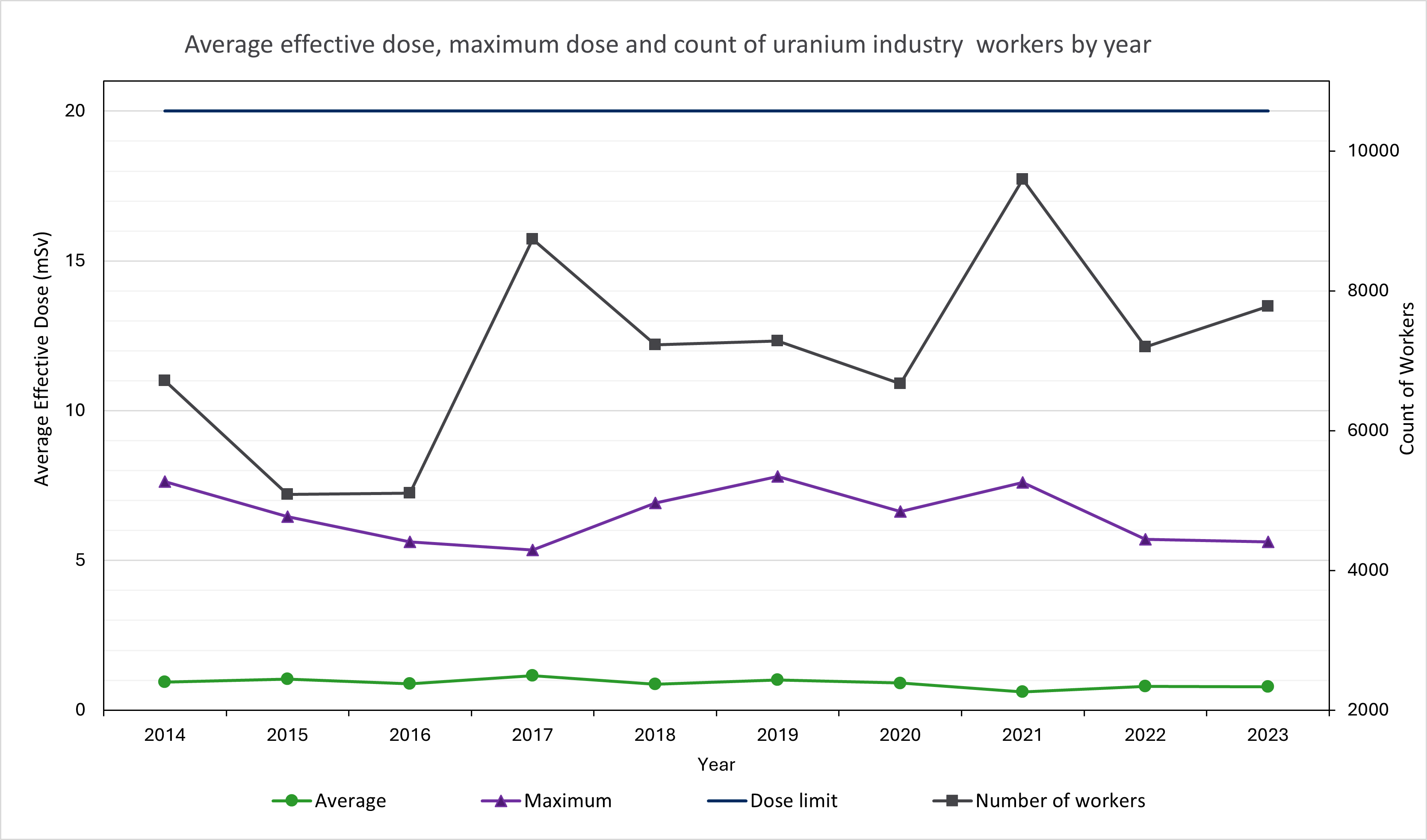
Figure 2 (below) shows the average effective doses for each of the work categories ‘mining’, ‘processing’ and ‘other’ (‘other’ includes administrative and support staff).
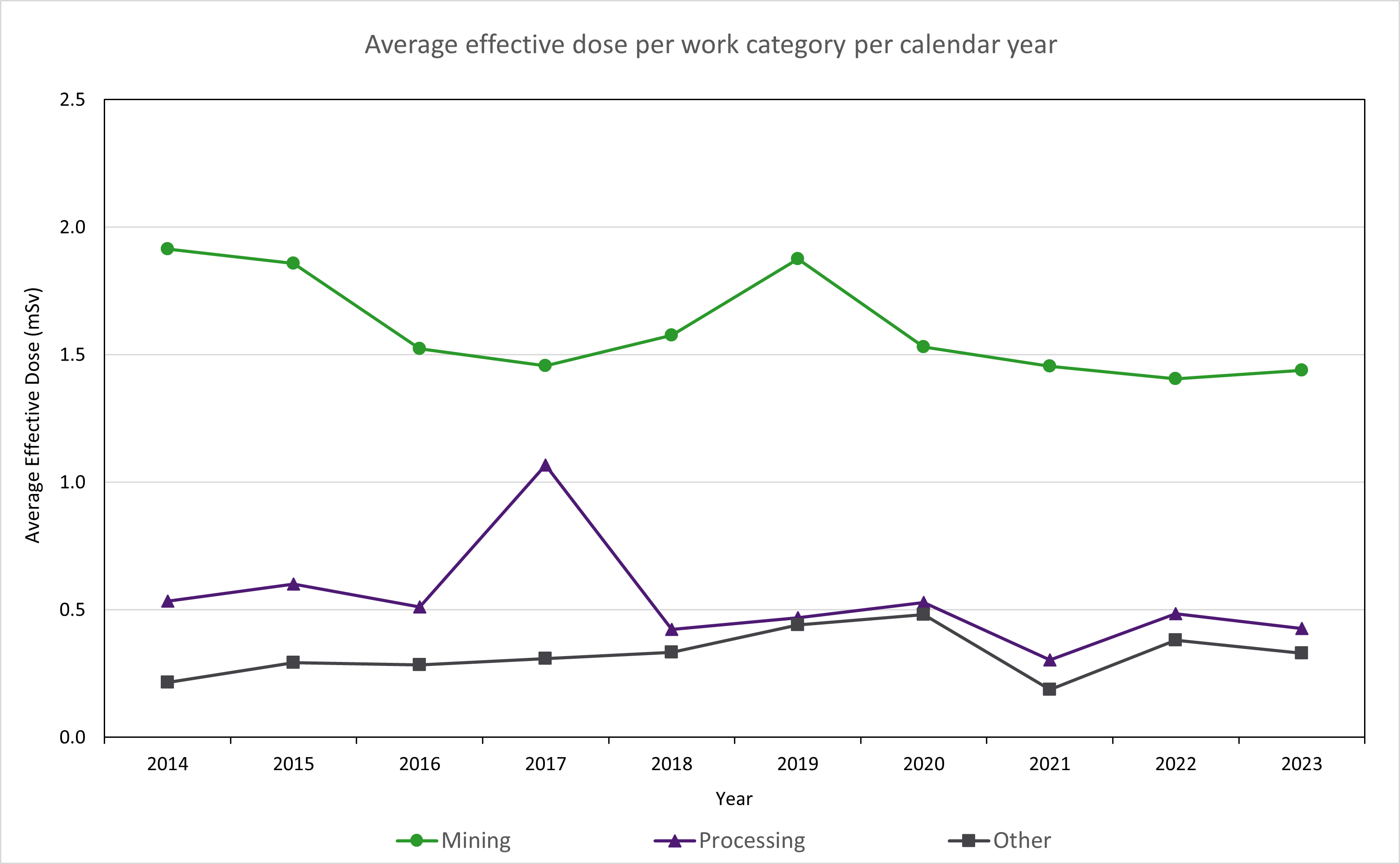
The average effective dose for miners has increased from 1.40 mSv in 2022 to 1.44 mSv for 2023 while the average effective dose for process workers decreased from 0.49 mSv in 2022 to 0.43 mSv in 2023. The trend for average effective dose over time for the ‘others’ work category mirrored and followed the dose trend for process workers with an average effective dose of 0.38 mSv in 2022 before decreasing to 0.33 mSv in 2023.
In determining these averages, for workers that had more than one work category within a year, the worker was assigned to the category in which they received the highest dose.
Collective effective dose
The collective effective dose can be used as a comparative tool for the optimisation of radiation protection practices. It has been used by UNSCEAR for reporting and comparing exposures from different practices around the world (UNSCEAR 2008).
The collective effective dose (CED) is the sum of the individual doses incurred by a group. The unit of CED is the ‘person-sievert’ (person Sv); this distinguishes the collective dose from the individual dose (IAEA 2007). Collective effective doses from the uranium industry, for the work categories ‘mining’ and ‘processing’, are shown in Table 1.
| Worker Category | Year | Collective Effective Dose (personSv) | Number of Workers |
| Mining | 2019 | 5.41 | 3,007 |
2020 | 4.02 | 2,748 | |
2021 | 3.75 | 2,669 | |
2022 | 3.47 | 2,527 | |
2023 | 4.01 | 2,890 | |
| Processing | 2019 | 1.98 | 4,443 |
2020 | 2.01 | 4,064 | |
2021 | 2.04 | 7,079 | |
2022 | 2.21 | 4,770 | |
2023 | 2.06 | 5,032 |
Table 1: Collective Effective Dose for Uranium Mining and Processing Workers (2019 – 2024)
Exposure pathway assessment
A review of the exposure pathways, inhalation of particulate, inhalation of radon progeny and external gamma for the work categories of miners and processing workers identifies the dominant pathways that require the focus of control for uranium mining operators.
The average effective dose by pathway for miners is shown in Figure 3 (below). This clearly shows that inhalation of radon progeny and exposure to external gamma radiation dominant the total effective dose for this work category with the contribution of both being roughly similar since 2020. The inhalation of particulates for this work category continues to contribute only a minor proportion of the total dose.
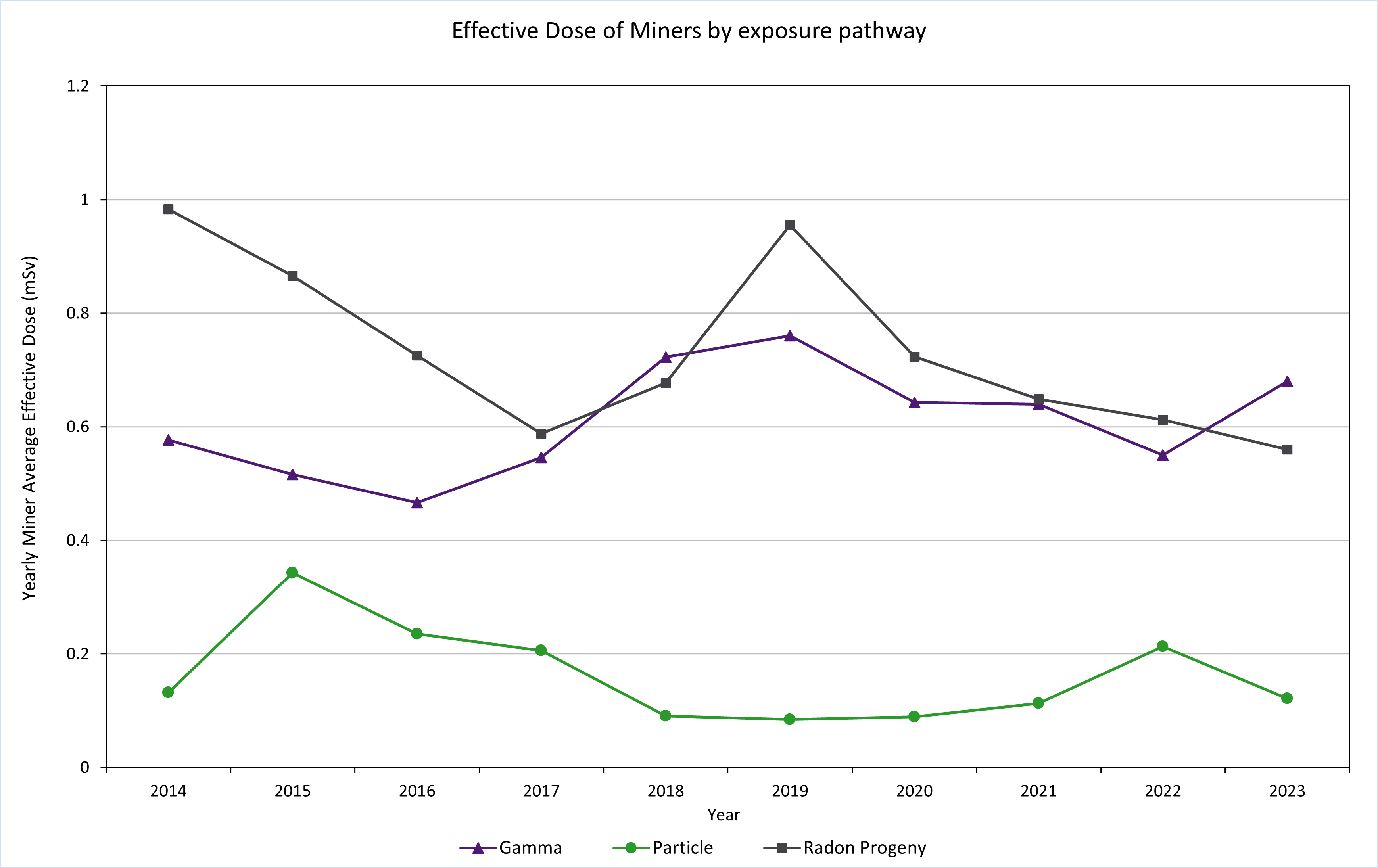
Figure 4 (below) shows the effective dose by exposure pathway for processing workers where the inhalation of particulates is the dominant pathway of exposure due to their work around ore crushing, product packing and even smelter facilities while inhalation of radon progeny and exposure to external gamma radiation are similar and are about half the exposure of that to particulates.
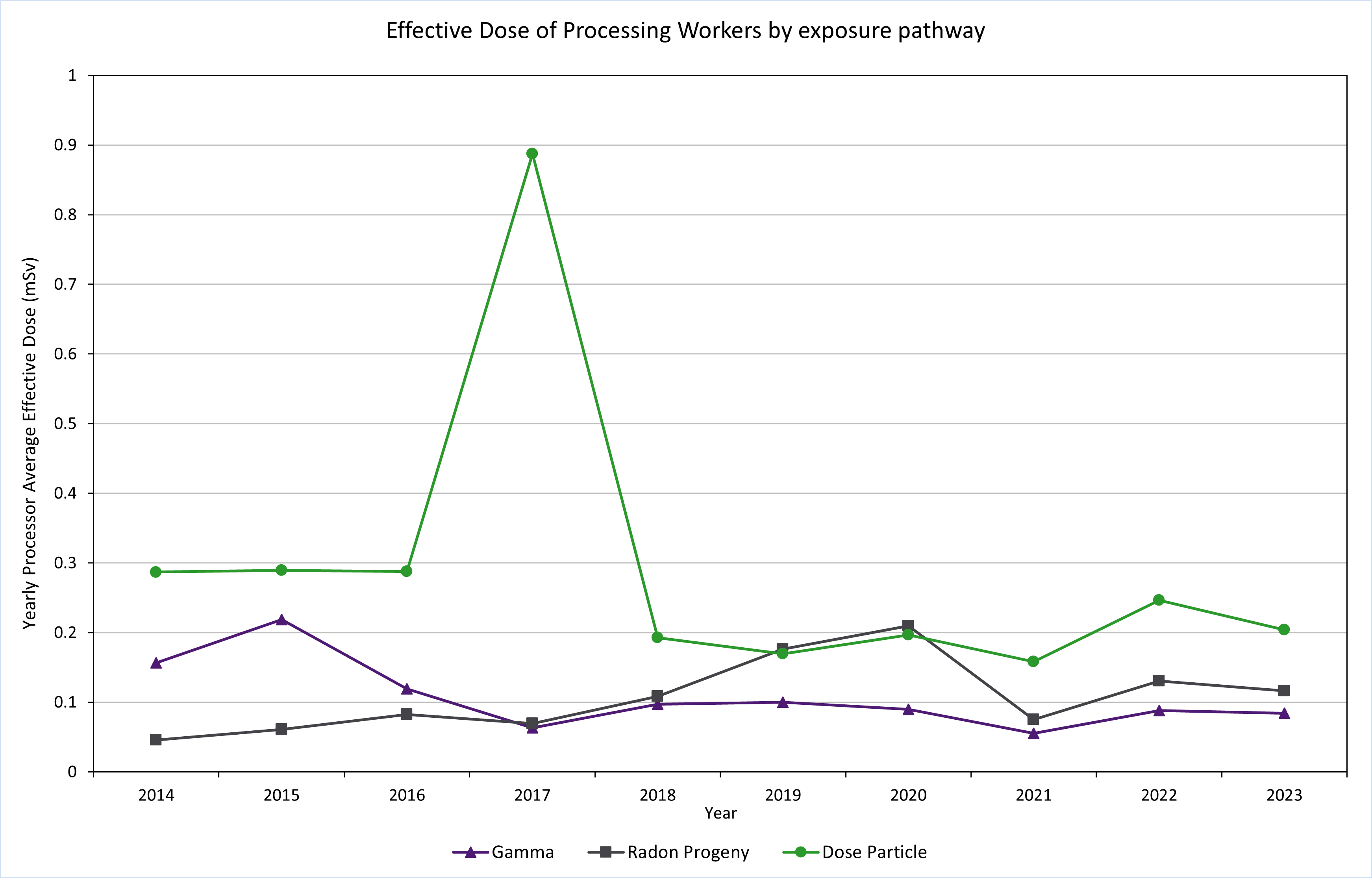
Commonwealth licence holder data
Reported doses
Since an amendment was made to the ARPANS Regulations in 2017, relevant Commonwealth organisations must submit dose records to the ANRDR. Given this, no data relating to the period prior to 2017 is available for analysis.
The four largest submitting organisations are the Australian Nuclear Science and Technology Organisation (ANSTO), the Commonwealth Scientific and Industrial Research Organisation (CSIRO), the Australian National University (ANU) and the Australian Radiation Protection and Nuclear Safety Agency (ARPANSA). These organisations consist of scientific and university researchers, regulatory authorities, nuclear installations, and other source licence holders. For this review the work categories ‘scientific research’, ‘university research’, ‘nuclear facilities’ and ‘miscellaneous’ have been used to group Commonwealth licence holder-workers, where ‘miscellaneous’ includes regulators and other source licence holders. Figure 5 (below) shows the average effective dose for each of these categories per year for the years 2017 – 2023.
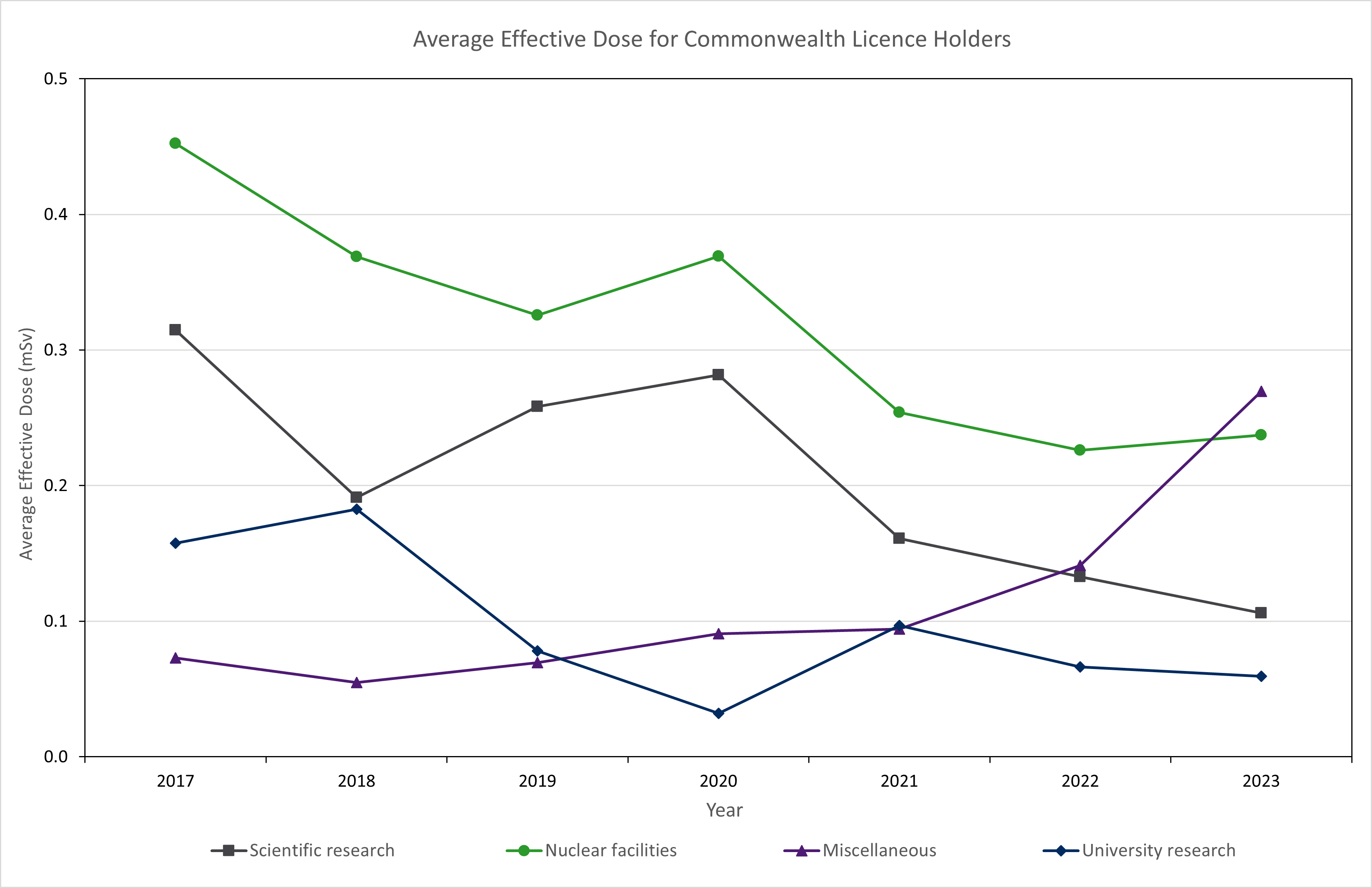
Top 100 doses for Commonwealth organisations
Review of the top 100 doses from submitting Commonwealth organisations can help regulators to tailor their inspection regime and to facilitate discussions with their licence holders. The top 100 doses from Commonwealth organisations for the year 2023 are provided in Figure 6.

The maximum, average and minimum doses, from the top 100 doses for each year, are presented in Table 2 (below).
| 2023 |
Maximum (mSv) | 5.86 |
Average (mSv) | 1.47 |
Table 2: Dose statistics for top 100 doses from Commonwealth licence holders for 2023
All workers
Dose distribution
The data from all organisations submitting to the ANRDR has been analysed to produce dose distribution histograms for 2023; that histogram is presented in Figure 7 (below). This is an effective way to demonstrate the distribution of occupational exposures and can minimise the impact of data skewing for doses that have been reported as less than the minimum reportable dose (< MRD).
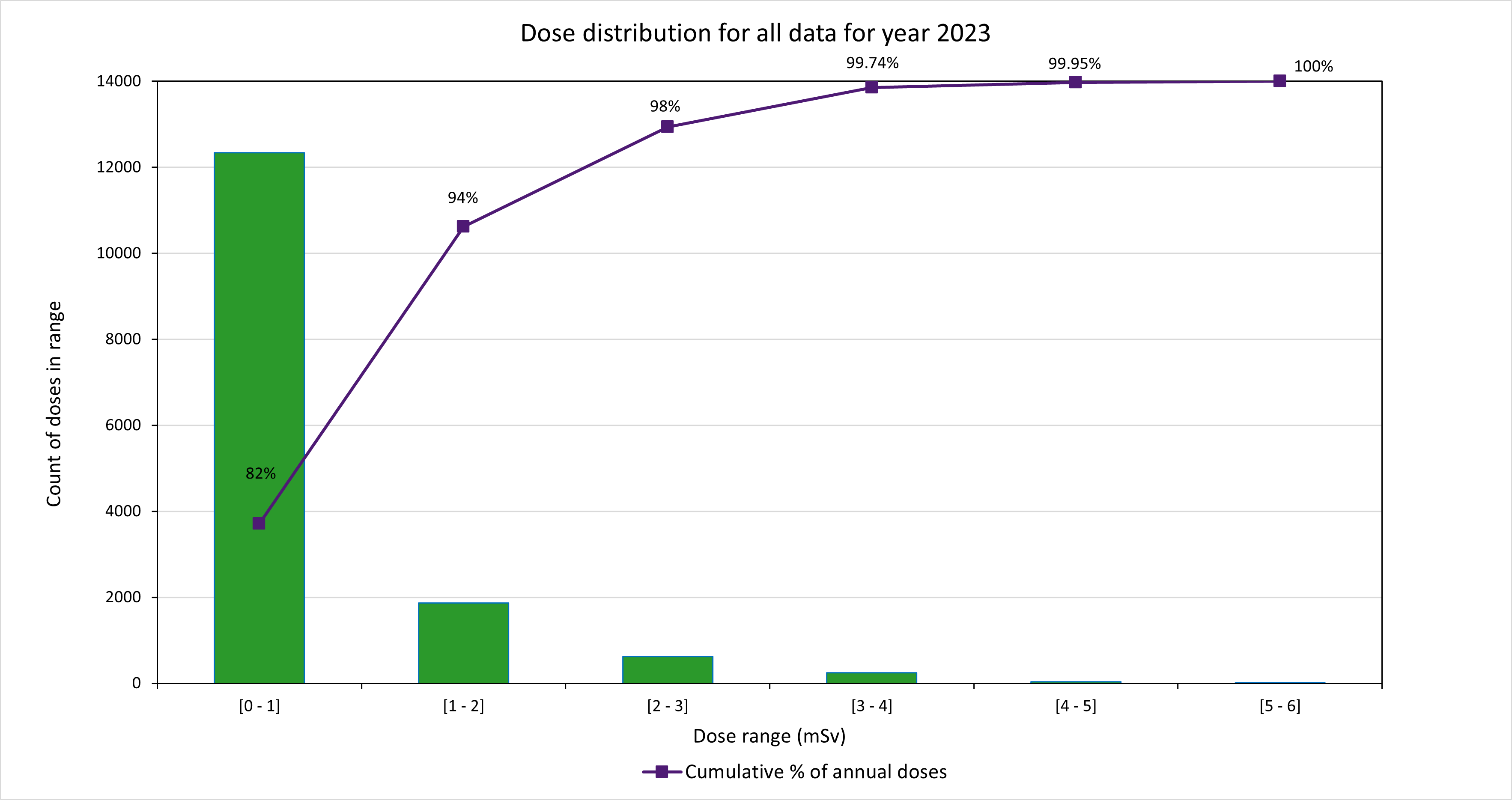
The maximum and average effective doses for all workers in the ANRDR for the year 2023 are presented in Table 3 (below).
| 2023 |
Maximum (mSv) | 5.86 |
Average (mSv) | 0.55 |
Table 3: Dose statistics for all workers for years 2023
Analysis of the cumulative frequency of the doses reported to the ANRDR for 2023 shows that approximately 82% of workers received a dose less than 1 mSv and 98% received a dose less than 3 mSv. These values are well below the occupational exposure limit of 20 mSv per year. No reported worker doses exceeded half of the occupational exposure limit.
Conclusion
The ANRDR maintains complete coverage of occupational radiation exposures for the uranium mining industry as well as collecting doses for a range of Commonwealth licence holders. In relation to those workers working in the uranium mining industry or for relevant Commonwealth license holders, the data shows that, maximum and average, occupational radiation exposures are below the annual dose limit; furthermore, the data shows that for these workers, occupational exposure to ionising radiation in Australia is well controlled.


